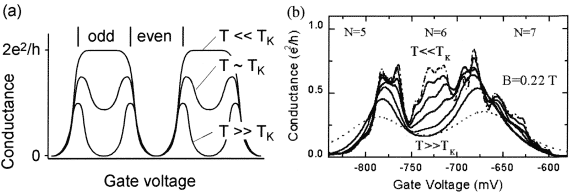Physical Science Laboratory
Quantum dots, in which electrons are confined by semiconductor nano-structures, show the quantum mechanical duality (particle- and wave-nature) for the electrons; the number of the electrons in the quantum dot is precisely controllable and discrete energy states are formed as a result of electron-wave interference. Moreover, many electron-spin related phenomena have been investigated in quantum dots. Since the electronic states in quantum dot resemble natural atoms, quantum dots are often called artificial atoms. The properties of quantum dots that can control a single electron-spin are promising for an application to the element (quantum bit) that realizes quantum information processing, such as quantum computers. In order to explore the possibility of quantum gates that correlate quantum bits, Kondo effects in quantum dots are attractive for their spin correlated transport.
The Kondo effect in quantum dot is a quantum mechanical co-tunneling process caused by the electron-spin interaction between electrons in the quantum dot and electrons in the lead. Even when the electron transport is restricted by Coulomb blockade effect, an electron can flow through the dot by making spin correlated singlet state if the dot has an electron-spin. The Kondo effect normally appears when the dot has odd number of electrons (total spin 1/2), but is absent when the dot has even number of electrons (total spin 0). The conductance through the dot is enhanced by the Kondo effect as opposed to classical Coulomb blockade effect, and at a low temperature the conductance is expected to reach 2e2/h, which is called unitary limit (see Fig. 1(a)). We successfully achieved the unitary limit Kondo effect and confirmed the coherent electron transport for the Kondo effect from electron interference experiments [1]. Furthermore, application of magnetic field allows us to tune the dot to the specific spin degenerated state. Even if the number of electrons is even (N = 6 for Fig 1(b)), energy degeneracy between spin singlet state and triplet state makes the spin correlation more possible, and thus remarkable novel Kondo effect shows up [2]. The series of experiments indicate that the electron-spin correlation can be well controlled in a quantum dot.
This work is collaborated with Prof. L. P. Kouwenhoven at TUDelft, Prof. S. Tarucha at University of Tokyo (also at ERATO and NTT) and co-workers.
[1] W. G. van der Wiel et al., Science 289 (2000) 2105.
[2] S. Sasaki et al., Nature 405 (2000) 764.

| Fig. 1. | (a) Temperature dependence of the conductance (Schematic). (b) Novel Kondo effect appears for even number of electrons (N = 6), if single and triplet states are degenerated. |